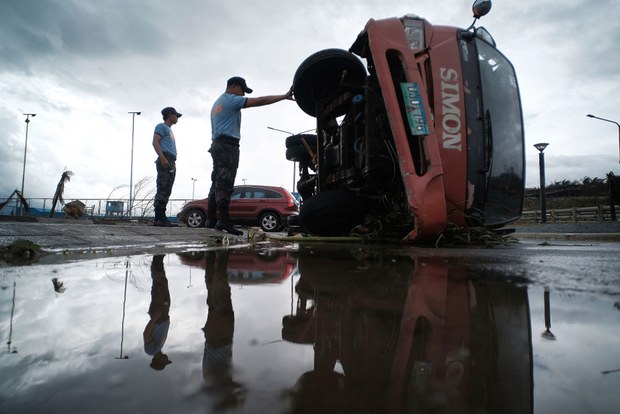Philippines: Kammuri Death Toll Rises as Typhoon Moves Farther Out to Sea
2019.12.04
Legazpi and Cotabato, Philippines
 Philippine police inspect a truck damaged by Typhoon Kammuri in Legazpi city, southeast of Manila, Dec. 3, 2019.
Philippine police inspect a truck damaged by Typhoon Kammuri in Legazpi city, southeast of Manila, Dec. 3, 2019.
At least 17 people were killed when typhoon Kammuri unleashed widespread flooding and damaging winds across the Philippines, police said Wednesday, as authorities deployed teams to island provinces to assess the destruction.
The storm, locally known as Tisoy, with maximum sustained winds of almost 215 kilometers per hour (134 miles per hour) – the equivalent of a Category 4 hurricane that often causes catastrophic damage – first made landfall in Sorsogon province in the east late Monday. It slammed three other regions as it tracked westward toward the South China Sea.
In its latest advisory Wednesday afternoon, the state weather bureau PAGASA said the storm was located 380 kilometers (237 miles) west of Zambales province with maximum sustained winds weakening to 95 kph (59 mph).
Authorities said they had lifted all tropical cyclone wind signal warnings as the storm’s center moved outside of the country’s landmass.
Of the total number of fatalities, the national police reported that five bodies had been recovered in the eastern Bicol region; five in Oriental Mindoro; two in Marinduque province; one in central Ormoc City; and four in the provinces of Batangas and Quezon, south of Manila.
Mark Timbal, spokesman for the National Disaster Risk Reduction and Management Council, said that they have yet to release an official death toll as they just deployed their teams to conduct assessment.
“We are still confirming the identities or cause of death,” Timbal told reporters. “We are verifying the details because they are eligible for financial assistance.”
The storm displaced almost 500,000 residents, toppled power lines, shut down airports and disrupted some events in the Southeast Asian Games, which is taking place in the country until Dec. 11.
Claudio Yucot, a regional director of civil defense office, said majority of electricity remain unavailable in the provinces badly-hit by the typhoon in southern Luzon, the main Philippine island.
“We have to wait for the inspection and total assessment of the power providers since lots of posts and lines were damaged,” Yucot told reporters.
Lea Guerrero, head of Greenpeace Philippines, said the Philippines has been facing a “climate emergency” for decades now, and that the recent storm has driven home the point.
“Year after year, Filipinos are identified among the most impacted globally by this crisis, an emergency situation made worse by the big polluters, fossil fuel companies … who have been raking in trillions in profits at the expense of millions of people who suffer from its impacts,” Guerrero said.
At least 20 tropical storms hit the Philippines each year, some of them devastating. In November 2013, almost 7,000 people died when Supertyphoon Haiyan battered the central portion of the archipelago, bringing deadly storm surges that inundated cities and towns.







